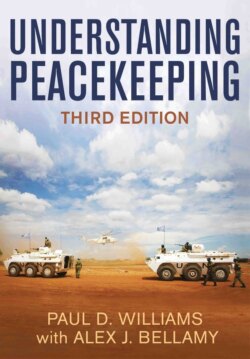Читать книгу Understanding Peacekeeping - Alex J. Bellamy - Страница 13
Introduction
ОглавлениеSince the late 1940s, peace operations have become one of the principal international instruments for managing armed conflicts. Nearly 200 such missions have been conducted in every region of the world by a range of multinational organizations and coalitions of states. Peace operations have assumed a wide range of shapes and sizes but they share some important family resemblances. First, all peace operations stem from a desire on the part of the actors that authorize and participate in them to limit the scourge of war. Second, peace operations are almost always collective endeavours undertaken by multiple actors for purposes that go beyond the interests of any one of them. Third, these missions have always been ad hoc responses to particular problems, most notably how to manage and potentially help resolve armed conflicts. Fourth, they are principally political instruments with an admixture of military force, which is usually intended to provide assurances to the conflict parties.
With these family resemblances in mind, this book focuses on peace operations that involve the expeditionary use of military personnel, with or without UN authorization, with a mandate or programme to:
1 assist in the prevention of armed conflict by supporting a peace process;
2 serve as an instrument to observe or assist in the implementation of ceasefires or peace agreements; and/or
3 enforce ceasefires, peace agreements or the will of the UN Security Council in order to build stable peace.
Peace operations often include civilian personnel working alongside their military colleagues, but our focus is not on missions that deploy only civilians, which generate rather different dynamics than those involving contingents of troops. Understood in this manner, peace operations are one type of activity that can be used to prevent, limit and manage violent conflict as well as rebuild states and societies in its aftermath. Other instruments in the international toolkit are conflict prevention, peacemaking, peacebuilding, sanctions, humanitarian military intervention, and transitional justice mechanisms.
Not surprisingly, there have often been heated debates about what peace operations are for and what strategies and tactics peacekeepers should employ to achieve their objectives. These differences revolve around competing conceptions of the causes and nature of violent conflict, disputes about the relative value of sovereignty and human protection, arguments over the foundations of stable peace, and contending political priorities.
Within this broad remit to manage armed conflict, the world’s peacekeepers have been mandated to perform a daunting and growing range of tasks, frequently in areas where there is no peace to keep. As well as the original tasks of confidence-building and ceasefire monitoring, modern peacekeepers have been tasked with helping to implement peace agreements; preventing the outbreak of hostilities; supporting local police and military forces; protecting humanitarian and official personnel and facilities; providing maritime security; engaging in security monitoring, patrolling and deterrence activities; ensuring the free movement of personnel and equipment; security-sector reform (SSR); demilitarization and arms management; facilitating humanitarian support; promoting human rights and the women, peace and security (WPS) agenda; strengthening the rule of law and judicial institutions; assisting local political processes; delivering electoral assistance; supporting state institutions; facilitating international cooperation and coordination; supporting the implementation of sanctions regimes; disseminating public information; promoting civilian–military coordination; contingency planning; conducting mission impact assessment; combating and sometimes ‘neutralizing’ so-called spoiler groups; and, perhaps most fundamentally, protecting civilians, including refugees and internally displaced persons (IDPs).
When it comes to understanding peacekeeping, therefore, the stakes are very high. Done well, peace operations can significantly improve the chances of building stable peace in the world’s war-torn territories. Done poorly, however, peace operations can be ineffective and exacerbate some of the problems. It is imperative that students, analysts and practitioners alike have a sophisticated understanding of peacekeeping – its key concepts and theories, its contested histories, its place in global politics, its different variants and its contemporary and likely future challenges. That is the purpose of this book.
